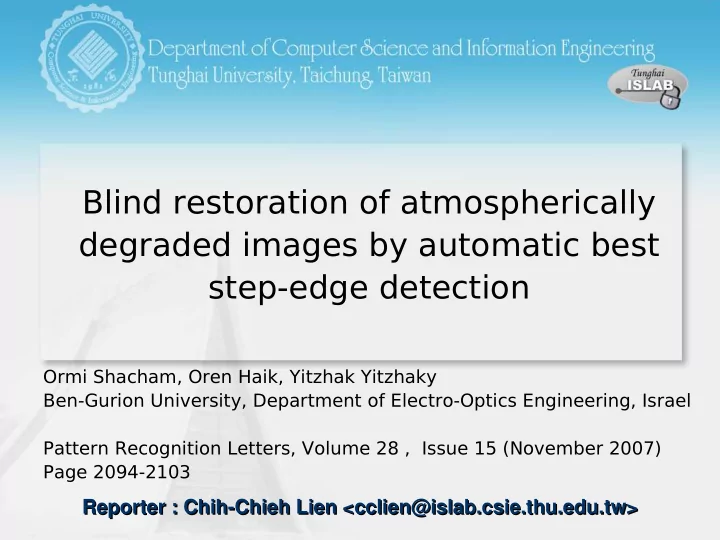

Blind restoration of atmospherically degraded images by automatic best step-edge detection Ormi Shacham, Oren Haik, Yitzhak Yitzhaky Ben-Gurion University, Department of Electro-Optics Engineering, Israel Pattern Recognition Letters, Volume 28 , Issue 15 (November 2007) Page 2094-2103 Reporter : Chih-Chieh Lien <cclien@islab.csie.thu.edu.tw> Reporter : Chih-Chieh Lien <cclien@islab.csie.thu.edu.tw>
Outline Blind restoration Atmospherically degraded image Proposed method Experimental Result Conclusion
Blind restoration Only available data is the recorded image itself. An image restoration process in this case is called blind restoration.
Atmospherically degraded images In horizontal long-distance imaging Degraded due to atmospheric effects
Proposed method Atmospheric MTF Degraded Edge detection Calculated image Restored Wiener filter image
Edge detection Canny edge detection used to produce single-line edge, Provides non-broken edges Evaluation of edge length and straightness Small-scale evaluation Large-scale evaluation
Small-scale evaluation Weighting code given by relationship with neighbors. Have one or zero neighbor: 1 Has neighbors angels of 45,90,135,180 will be assigned 2,3,4, and 5
Small-scale evaluation
Small-scale evaluation Provide information for Large-scale evaluation: Locate longer straight edges
Edge detection: Result
Contract and homogeneity of edge sides Examine which edges has high contrast and homogeneous regions from both sides (step-edge) Done by taking a square region surrounding the center pixel of the edge and observing the histogram of the pixels in that area.
Contract and homogeneity of edge sides
Contract and homogeneity of edge sides Small size of the square region will have a better chance to be the image of a close to an ideal step-edge. But it should be large enough to include the whole significant part of the atmospheric blur.
Calculation of the atmospheric MTF and image restoration Using the step-edge obtained to calculate MTF (Modulation Transfer Function) H(u,v). Extracted MTF is used for restoring the atmospherically degraded image.
Result: synthetically blurred image
Result: synthetically blurred image
Result: real degraded image
Conclusion The method in the paper seems works well in real degraded images. A good edge detection is very important for image restoration.
END
Recommend
More recommend